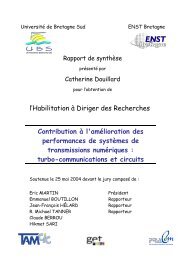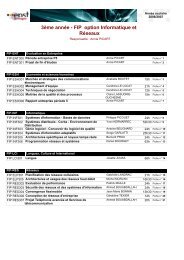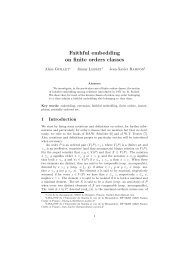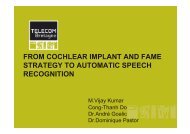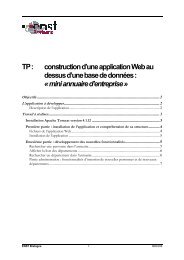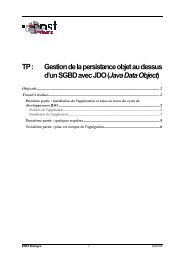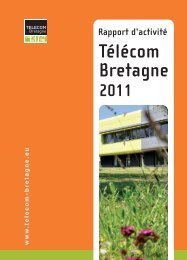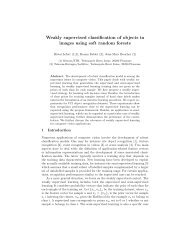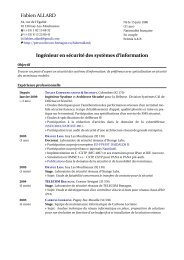researResearch - Télécom Bretagne
researResearch - Télécom Bretagne
researResearch - Télécom Bretagne
You also want an ePaper? Increase the reach of your titles
YUMPU automatically turns print PDFs into web optimized ePapers that Google loves.
h Research<br />
9<br />
RESEARCH<br />
2. Simulation of sonar signals and scene<br />
interpretation<br />
Simulating signals is a crucial tool in remote<br />
detection, because it is very complicated and<br />
costly to carry out experiments in situ. For years,<br />
an evolving sonar signal simulator has been<br />
under construction. After attempts with a<br />
simulator based on acoustic ray launching, the<br />
current energy tube engine makes it possible to<br />
calculate precise energy balance. Until now,<br />
simulations were carried out with tubes that only<br />
deal with signal amplitude, in addition to the<br />
propagation history.<br />
Simulated sidescan sonar images using real bathymetric data (French<br />
coast near Paimpol area).<br />
Consequently, the current work on the sonar<br />
simulator mainly concerns the generation of the<br />
full signal using both convolutions with the scene<br />
and acoustic tube propagation history. A first step<br />
was taken in the testing of the notion of discrete<br />
backscatterers: this concept allows a coherent<br />
signal to be exactly computed. This work was the<br />
subject of a publication at the Oceans 2008<br />
conference. Currently, the integration of this<br />
functionality is underway in the energy-based<br />
engine of the simulator. Additionally, producing<br />
speckle noise based on this backscatterers<br />
approach is producing first results.<br />
3. Tridimensional reconstruction<br />
of underwater "scenes" from sonar image<br />
sequences<br />
The perception of underwater scenes from<br />
optical sensors (video, for example) is a task too<br />
difficult, even impossible, as the turbidity of the<br />
water increases. This is why the use of new<br />
DIDSON-type high-resolution acoustic cameras<br />
appears to be so interesting. In effect, these<br />
sensors, due to their ease of use and the high<br />
level of resolution of the images they produce,<br />
make them powerful tools in areas such as semiautomatic<br />
control of port infrastructures<br />
(detecting, identifying and automatically mapping<br />
signs of use, for example) or the observation of<br />
underwater fauna. Given the small size of these<br />
acoustic cameras, these inspection approaches<br />
can be carried out by autonomous vehicles (AUV)<br />
with a front-looking camera. Thus, depending on<br />
the vehicle trajectory and attitude, the<br />
underwater scene is observed several times,<br />
with different incidence angle. Sequences of<br />
sonar images are thus collected where the<br />
entities involved in the scene appear several<br />
times, under a variety of angles. The aim of this<br />
study is therefore to use this redundancy of<br />
observation to reconstruct the scene observed in<br />
3D, from a series of 2D images.<br />
Geometrical acquisition model for DIDSON imaging sensor.<br />
Phase simulation resulting from phase delay using several extended<br />
scatterers<br />
Several scenarios can be imagined, according to<br />
the nature of either the camera movements or<br />
the behaviours of the entities involved in the<br />
scene. With a static scene observed by a moving<br />
camera, or a scene observed by a static camera,<br />
but whose entities are moving, it is possible to<br />
draw on stereovision techniques to deduce from<br />
a couple of sonar images the topography of the<br />
underlying scene. Several major differences<br />
139



